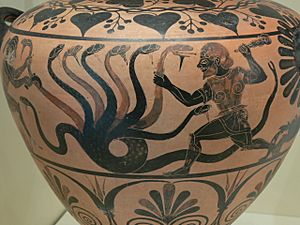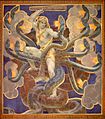Hydra (mythology) facts for kids
| Parents | Typhon and Echidna |
|---|---|
| Mythology | Greek mythology |
| Other name(s) | Lernaean Hydra |
| Country | Greece |
The Lernaean Hydra or Hydra of Lerna (Greek: Λερναῖα Ὕδρα, Lernaîa Hýdra), more often known simply as the Hydra, is a serpentine water monster in Greek and Roman mythology. Its lair was the lake of Lerna in the Argolid, which was also the site of the myth of the Danaïdes. Lerna was thought to be an entrance to the Underworld. In the canonical Hydra myth, the monster is killed by Heracles (Hercules) as the second of his Twelve Labors.
Origin
According to Hesiod, the Hydra was the offspring of Typhon and Echidna. It had poisonous breath and blood so virulent that even its scent was deadly. The Hydra possessed many heads, the exact number of which varies according to the source. Later versions of the Hydra story add a regeneration feature to the monster: for every head chopped off, the Hydra would regrow two heads. Heracles required the assistance of his nephew Iolaus to cut off all of the monster's heads and burn the neck using a sword and fire.
Second Labor of Heracles
Eurystheus, the king of the Tiryns, sent Heracles (or Hercules) to slay the Hydra, which Hera had raised just to slay Heracles. Upon reaching the swamp near Lake Lerna, where the Hydra dwelt, Heracles covered his mouth and nose with a cloth to protect himself from the poisonous fumes. He shot flaming arrows into the Hydra's lair, the spring of Amymone, a deep cave from which it emerged only to terrorize neighboring villages. He then confronted the Hydra, wielding either a harvesting sickle (according to some early vase-paintings), a sword, or his famed club. As one head was cut off, the creature grew back two. The weakness of the Hydra was that it was invulnerable only if it retained at least one head.
Realizing that he could not defeat the Hydra in this way, Heracles called on his nephew Iolaus for help. His nephew then came upon the idea (possibly inspired by Athena) of using a firebrand to scorch the neck stumps after each decapitation. Heracles cut off each head and Iolaus cauterized the open stumps. Seeing that Heracles was winning the struggle, Hera sent a giant crab to distract him. He crushed it under his mighty foot. The Hydra's one immortal head was cut off with a golden sword given to Heracles by Athena. Heracles placed the head—still alive and writhing—under a great rock on the sacred way between Lerna and Elaius, and dipped his arrows in the Hydra's poisonous blood. Thus, his second task was complete.
The alternate version of this myth is that after cutting off one head he then dipped his sword in its neck and used its venom to burn each head so it could not grow back. Hera, upset that Heracles had slain the beast she raised to kill him, placed it in the dark blue vault of the sky as the constellation Hydra. She then turned the crab into the constellation Cancer.
Heracles would later use arrows dipped in the Hydra's poisonous blood to kill other foes during his remaining labors, such as Stymphalian Birds and the giant Geryon. He later used one to kill the centaur Nessus; and Nessus' tainted blood was applied to the Tunic of Nessus, by which the centaur had his posthumous revenge. Both Strabo and Pausanias report that the stench of the river Anigrus in Elis, making all the fish of the river inedible, was reputed to be due to the Hydra's poison, washed from the arrows Heracles used on the centaur.
When Eurystheus, the agent of Hera who was assigning The Twelve Labors to Heracles, found out that it was Heracles' nephew Iolaus who had handed Heracles the firebrand, he declared that the labor had not been completed alone and as a result did not count toward the ten labors set for him.
Constellation
Greek and Roman writers related that Hera placed the Hydra and crab as constellations in the night sky after Heracles slew him. When the sun is in the sign of Cancer (Latin for "The Crab"), the constellation Hydra has its head nearby. In fact, both constellations derived from the earlier Babylonian signs: Bashmu ("The Venomous Snake") and Alluttu ("The Crayfish").
In art
-
John Singer Sargent (1921)
-
Reverse of a 1914 medal by Fritz Eue commemorating General Erich Ludendorff
-
Portrait of Henri IV as Hercules pinning the Hydra of Lerna, an allegory of the Navarrese king's defeat of the Catholic League during the French Wars of Religion. Workshop of Toussaint Dubreuil, c. 1600.
See also
 In Spanish: Hidra de Lerna para niños
In Spanish: Hidra de Lerna para niños





